|
 DIPS FROM RESISTIVITY Image log (MICROSCANNER)
DIPS FROM RESISTIVITY Image log (MICROSCANNER)
With FMS and FMI data in the form of a digital image,
several image processing operations can be used to improve the
overall quality of the imagery. For example, systematic variations
between electrode responses are normalized, and dynamic or user controlled gray scale compensation
is used to enhance local image contrast and improve the fine image
detail. An example is shown in the next Section. Stretching, squeezing,
or clipping of the colour spectrum, or mapping of the gray
scale to colours, are common processing functions. Edge enhancement
or directional filters can also be applied to sharpen various
features seen on the images.
The
FMS Image Examiner is an interactive computer program for image
enhancement and dip calculation using data from the formation
microscanner. The program provides the analyst with the tools
to manipulate the image in many ways, one of which is to calculate
dip angle and direction. A simple example will illustrate the
technique. The illustration below shows the colour image from two passes
of the microscanner. Dark colours represent shale and light colours
are sandstone. Notice the detailed depth scale (shown in meters).
The white area is very high resistivity, probably a limestone
stringer.
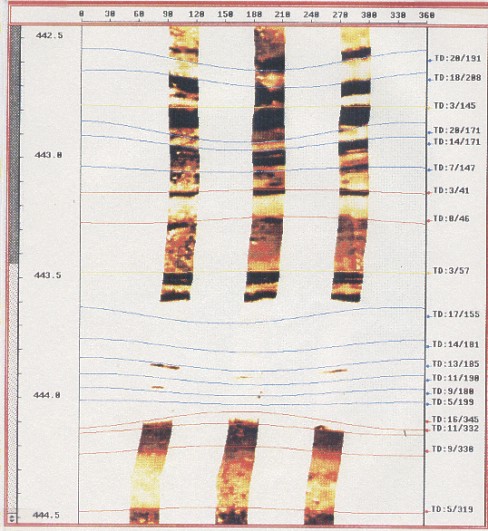  Image Examiner showing tight streak (white) in sand
shale sequence on formation
Image Examiner showing tight streak (white) in sand
shale sequence on formation
microscanner images
By
using a mouse to digitize bedding planes such as the thin shale
laminations and the boundaries of the limestone layer, the program
fits a sine wave to the points. The sine wave represents a plane
slicing through the borehole, and its dip and direction can be
calculated. These are displayed on the right edge of the screen.
It
is obvious that the sine waves shown within the white (limestone)
layer could not have been digitized from this image. In fact,
the image scale was enlarged, then the colour scale
was shifted to provide greater resolution in the
high resistivity band, turning previously bright colours into
black, and white into distinguishable colours. Now the bedding
planes can be digitized and dips computed.
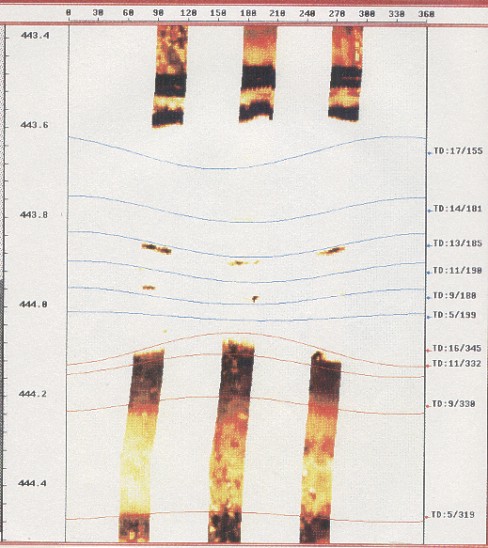
Expanded vertical scale image of tight streak
(white) on formation microscanner
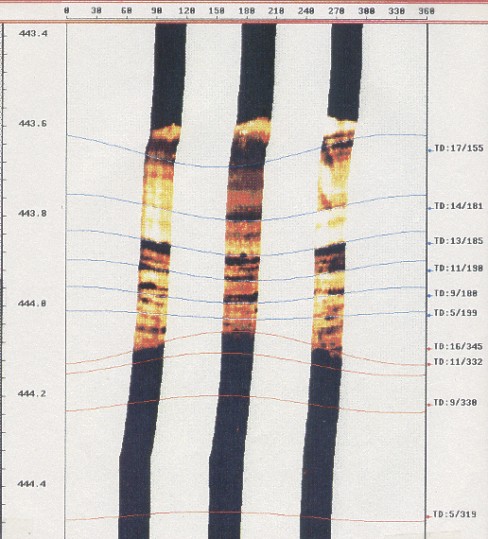
Expanded colour scale image of tight streak (light
brown) on formation microscanner
Dips
can also be computed automatically by the same methods as used
for the stratigraphic high resolution dipmeter. MSD, CSB, LOC,
FMS, and handpicked dips over the same interval are demonstrated
in the next several illustrations. Each plot has entirely different
dip results, emphasizing the need to understand the different
dip calculation methods. In particular, the MSD dips in a strongly
cross bedded formation suffer badly from the averaging calculation.
Compare the MSD with the CSB dips on the images. It is clear that MSD dips do not follow the bed boundaries very well and underestimate
dip angle at the sand top and base by 7 to 10 degrees.
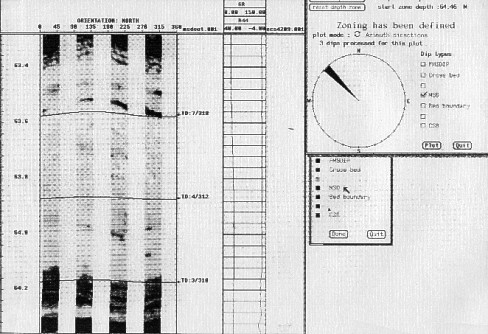
MSD dips picked from formation microscanner
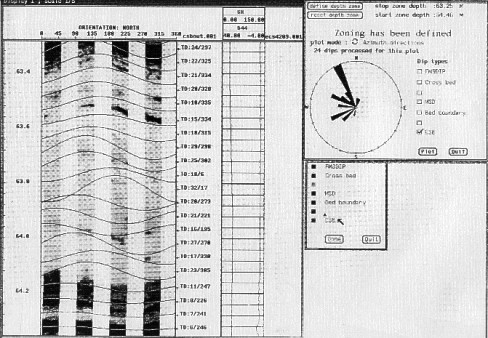
CSB dips picked from formation microscanner
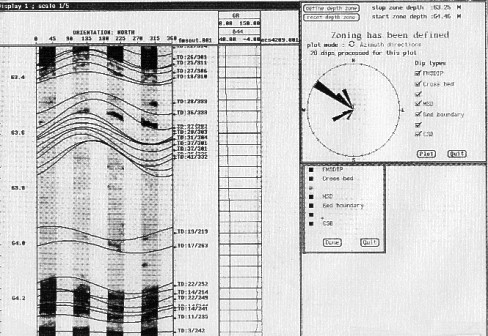
FMS dips picked from formation microscanner
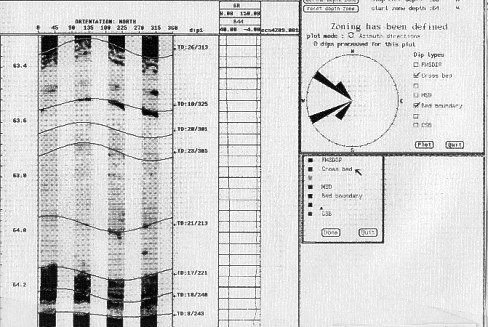
Hand picked dips picked from formation microscanner
The
FMS dips use a different form of correlation, so
they honour the bed boundaries even better. Computed dips are
even steeper than CSB and much steeper than the MSD, indicating
the relative degree of averaging being done by the program. The
hand picked data is probably the best result,
but it is labor intensive. It takes about half a day to compute
all FMS dips over a 300 foot interval, delete all unwanted dips
manually, and pick additional dips not found in the original computation.
You
should appreciate these differences when using any dipmeter. Any
form of best fit or averaged dip will probably underestimate dip
angle unless some very dominant bed boundary exists that will
swamp all others. The assumption made by the programmers is that
major bed boundaries do this, but as you can see from the illustrations,
this is not always true. If you can afford it, run FMS or televiewer
images to help interpret dipmeter arrow plots. Since the vast
majority of existing dipmeters cannot be augmented by FMS, BEWARE
of averaged results.
The
borehole televiewer, an ultrasonic borehole imaging tool, has
much resolution than the dipmeter based imaging tools. As a
result, only the largest dip and bedding features can be seen.
It is used mostly for fracture identification.
|

